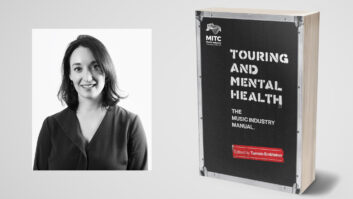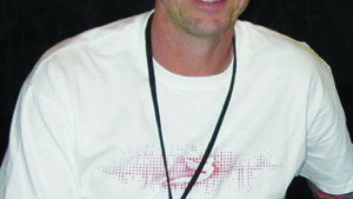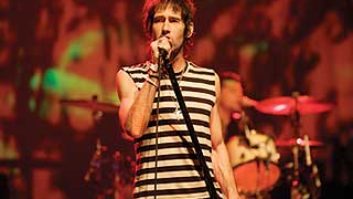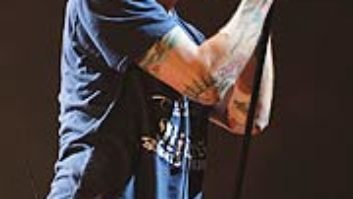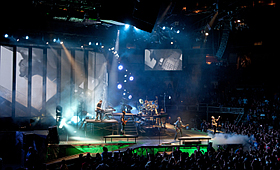
Linkin Park performing at San Jose, Calif.’s HP Pavilion
Photos: Steve Jennings

Linkin Park’s Chester Bennington (left) and Mike Shinoda
Linkin Park is a band that delivers—onstage, in the studio and just a few days post-gig. For the latter, front-of-house engineer Ken “Pooch” Van Druten and programming, playback engineer and keyboard tech Dylan Ely provide a fully mixed and mastered, pro-quality live album within two to three days after each performance. With a purchased ticket, each fan is offered a high-quality download of the live recording; distribution of the download is provided by Basecamp Productions.
“We have been releasing shows after the fact for about four years now,” Van Druten explains. “Dylan and I have mixed approximately 400 shows at this point. We were given the opportunity to mix a DVD release, Live at Milton Keynes, which was nominated for a Grammy [Best Hard Rock Performance, 2010]. It is one of the most fulfilling duties I have while working with Linkin Park. It is nice to know that any time you hear something that Linkin Park has done live, it is a mix that Dylan and I have done—minus a few things that their recording engineer, Ethan Mates, has done.”
For the live recordings, Van Druten and Ely spend about 24 work-hours per show prior to the release. As the band (Brad Delson, guitar; Chester Bennington, vocals; Joe Hahn, turntablist; Mike Shinoda, vocals; Phoenix, bass; and Rob Bourdon, drums) has mandated that they want “record-quality bootleg” recordings, Van Druten says that most of his and Ely’s time is spent shaping the sound of what is coming offstage with the sound of the actual room and making that work—creating a sonic landscape with the band’s full, rich sound with loud crowd response.
“Basically, there is a template that we have worked on now for about four years,” Van Druten says. “We insert that as a starting point and work from there. Dylan does most of the editing, I do the mixing and then it goes back to Dylan for more editing and mastering.”
For the recordings, Van Druten uses the HD X cards from his Avid D-Show Profile (96-input with five DSP cards) at FOH to record directly to Pro Tools HD at 24-bit/48 kHz (78 inputs total). The day after the gig, the two take the recording and import it into that template, which has inserts, sends and routing already set up. They then time-align the audience mics with the close mics (Audio-Technica models), edit any major mistakes and do some cleanup on tracks that aren’t being used for certain songs. “We then mix the cleanup tracks, treating them as a complete show, with no time in-between songs or cutting out encores,” Ely says. “The idea is to mix the show for the fan just as he or she would have heard it if they were attending the show. During the mix process, notes are made about any mistakes, then they’re addressed and fixed, and then it gets mastered. All songs are matched level- and EQ-wise within that show, as well as being compared and matched with previous shows. We then print as a 24-bit/48k WAV file.” That file is then converted to 320kbps MP3 files and uploaded to the Basecamp site via the company’s proprietary drag-and-drop software. “The whole process for a 90-minute show takes about 16 hours of post-production: a day of editing and a day of mixing,” Ely adds.

Front-of-house engineer Ken “Pooch” Van Druten.
BACK TO THE SHOW
To re-create much of the same electronic-rock fusion created in the studio to the live performance arena, Van Druten (who has been mixing for the band for the past five years) says his job “is to reproduce what is coming from the stage in a way that the audience hears every instrument and vocal,” Van Druten says. “Nowadays, it’s a bit more complicated. With technology, I am able to insert my own creativity into the mix to provide the audience with a record-quality listen.” This includes relying on choice plug-ins such as those from Waves, URS and McDSP. He taps into the Waves MetaFlanger for some intense vocal effects on the song “The Catalyst” (off of their latest release, A Thousand Suns). In his outboard rack are such pieces as an Apogee Big Ben word clock and M-Audio ProFire 2626 FireWire interface to record the 2-mix and audience mics to a MacBook Pro. “I have a Pro Tools HD4 Macintosh rig with an [Avid] Expansion chassis for the ability to record 96 inputs, one for one,” he adds, “a Waves Maxx BCL for recording of the 2-mix to eliminate some DSP usage, and an Alesis ML9600 hard disk recorder/CD burner for fast-turnaround of recorded stuff, plus playback.
“The last few years have been completely freeing because the technology allows me to reproduce all of the effects and sounds that were used when the band made the recording that people know and love,” Van Druten continues. “I have been a musician all my life—specifically, a bass player. I believe that the rhythm section is the key to every mix. I think of a mix as a houseplant: The drums and bass are the roots; the keys, vocals, guitars, et cetera, are the stems, leaves and flowers. It is not possible to have the stems, leaves and flowers without the solid, sturdy root system.”
All mics onstage are Audio-Technica (the band endorses the company), except for the RF and wired vocal mics, which are Sennheiser 865 Series. “My favorite microphones for guitars and basses—stringed instruments, in general—are the large-diaphragm Audio-Technica mics. I use the AT4050 and the AT4047 on all guitars. We have 86 inputs and about 60 of those are open microphones, so it’s really necessary to make the right mic placement and choices.”
Pumping the blistering sets to the audience is an Adamson Y-Axis system, with Van Druten noting the 18-inch speakers in the main array and 21-inch speakers in the subs as key to this band. “Both couple very nicely to reproduce low-mid to sub information that other P.A.s just can’t do,” he says, adding that he has three Dolby Lake processors for matrixing and zoning. In addition, he relies on systems engineer Chris “Cookie” Hoff and Evan McElhinney, who spend much of their time making sure that every seat in the house sounds the same and is covered. “I count on them greatly, and they are the best in the business,” Van Druten says.

Monitor engineer Kevin “Tater” McCarthy (left) and monitor systems engineer Paul “Pablo” White
Monitor engineer Kevin “Tater” McCarthy is also in constant contact with Hoff at the beginning of the tour to make sure his mixes were dialed in as the stage is diamond-shaped and the band plays downstage of the P.A. for most of the show. He is manning a Yamaha PM5DRH (the same model as when Mix caught up with this Linkin Park crew back in 2008) with a DSP5D (PM5D-EX system); outboard is all done via Waves SoundGrid multirack system. “I’m using all 24 mix outs, all eight matrices and the stereo out B,” McCarthy says. “I also use two outputs on the DSP5D. There are eight sidefill/wedge mixes, six IEM stereo mixes and a mono ear mix; the rest are effects and shakers.” The entire band except guitarist Delson are on JH Audio JH-16 ear monitors. The wedges (12 Adamson M12 underhung and two M12s onstage) and SX18s sidefills are for Delson, who wears generic foam earplugs with Peltor gun muffs over them. Power is via Lab.Gruppen PLM10000 amps.
In 2008, McCarthy was mixing from underneath a rolling stage. This time out, he’s located at upstage-center, completely behind the band, and using spy cams to keep track of what’s happening out front. “I am in constant contact with the band if they need something,” McCarthy says. “Plus, my assistant, Paul “Pablo” White, is an extra set of eyes and ears for me. Linkin Park and production manager Jim Digby are wonderful to work for and they give me all the tools I need for my job.”
Van Druten echoes McCarthy’s sentiments: “Truly, we are family on this tour. Some of the people here I have known for 20 years. When you are away from your ‘real’ family, it is really nice to know that your ‘tour family’ is always there for you. I couldn’t be happier with the situation. Great band, awesome crew—what’s not to love?”

Programming/playback engineer/keyboard tech Dylan Ely (left) and lighting director A.J. Pen
PROGRAM ME
Programming and playback are heavily involved in any Linkin Park adventure—be it in the studio or live. After engineer Dylan Ely receives the full album multitrack and the band determines which parts will be played live, he will make stems of those elements from the album that need to be programmed. He uses two Mac laptops (one is a redundant system) running Pro Tools M-Powered playing back all of the stems. The redundant machine is synched to the main machine via MTC, and the backup machine is set to Jam Sync the incoming MTC, “so if the main computer stops, loses power, et cetera, the backup machine will run infinitely at the same rate as it was when it lost timecode.”
Ely breaks down the eight tracks that comprise the stems:
Track 1: typically any low-frequency material, like 808s or maybe the low end of a drum loop that has the high frequency filtered off.
Track 2: usually any type of mono drum loop element that cannot be played live by the drummer.
Tracks 3 and 4: used for any type of sound that has to be stereo, typically a synth or string pad–type sound or a drum loop that is full-frequency with a stereo element to it.
Track 5: any high-end arpeggiated-type synth or a swell.
Track 6: click track that only is going to the bandmembers’ ears onstage.
Track 7: a reference track or a keyboard and/or vocal only heard in the singers’ ears onstage as a pitch reference. Also sometimes a click to “automate” a section for a certain member in their ears, only for a cue or reference.
Track 8: SMPTE. Tmecode is used to run/sync the lights and video during the show.
Sarah Benzuly is
Mix
’s managing editor.
